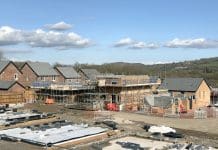Jason Hawthorne, MD, Wagstaffs explains how a digital model of London will help us make better decisions on homes for capital
As the UK braces itself for the uncertainty following Brexit, it is more important than ever that London looks at imaginative ways to address the housing crisis.
A new report* by Grant Thornton UK LLP and campaign group London First found that more than 72 per cent of employers in London were concerned about the impact high housing costs would have on staff recruitment and retention.
To keep up with demand we will have to fundamentally alter parts of London to build more housing. And illustrating proposed developments using 3D digital models, so that residents can visualise them, can help to secure support. The models can also help us to make better decisions by allowing us to see the cumulative impact of large scale housing development in context.
Grant Thornton’s report revealed 84 per cent of businesses believed that high housing costs posed a risk to the capital’s economic growth and that one in five firms were considering moving their business out of the capital to cope with the pressures of high housing costs. A truck was even spotted bearing a billboard where the Freie Demokraten invited start-ups to keep calm and move to Berlin, following the UK’s decision to leave the European Union.
It is crucial that we encourage businesses to stay in the capital city to ensure London’s survival as a centre for economic growth, now more than ever. But if young people and businesses are priced out of the market, it could damage London’s long term viability.
In another report released by London First, carried out by the law firm Dentons, it calls on City Hall to become a more muscular body, which acquires land from public bodies and uses compulsory purchase powers, where appropriate, to get homes built. It argues the Mayor’s task force, Homes for London, should assemble sites around core public land holdings and set out an acceptable level of density for development.
Grant Thornton’s report meanwhile suggests businesses could buy properties for employees or offer a credit facility to help meet the costs of a season ticket.
London needs to build around 50,000 homes a year to keep up with demand. But where will these homes be located? What will they look like? How will local infrastructure cope? What sort of density would be appropriate and how tall should these buildings be? What will our skyline look like in the years to come and how will this change the character of London? And what about historic views of the city?
What impact Brexit will have on London’s property market and construction industry remains to be seen, but the city’s housing crisis remains as deep as ever.
Grant Thornton and London First came up with a raft of suggestions to battle the housing crisis in their recent reports. But another way to plan London’s development and help to answer the complex questions around development is by using a digital model to achieve an overview of the capital from macro to micro.
Recognising the need to digitally model all of central London and create a world class city map, VUCITY was the culmination of work over the past few years, combining our digital visualisation tools, with Vertex Modelling’s experience of accurately modelling London for over 10 years. It is a joint venture between Wagstaffs, GIA and Vertex Modelling. VUCITY is the first ever fully interactive 3D digital model of London, covering more than 160 square kilometres of Central London.
Digital models can help us do a lot more than just visualise London. You can overlay data interactively, toggling between existing and consented developments, offering a macro and detailed understanding of the planned development in London. This would help us to understand the cumulative impact of housing development in context.
The model can be used to overlay sightlines, the London View Management Framework, transport links and sunlight paths to help the council planners understand proposals in context, as well as embedding live data feeds such as traffic cameras.
In a city that needs to grow, visualising the data that is available to us is the only way to effectively plan London’s evolution. Using a 3D digital model will help to answer some of the questions around new developments, see their impact and inform how we can come up with solutions. This new technology will future proof London in a way that has never been seen before.
* Released in July by Grant Thornton UK LLP, working with campaign group London First.
Jason Hawthorne
Managing Director
Wagstaffs
http://wagstaffsdesign.co.uk/vucity-2/













